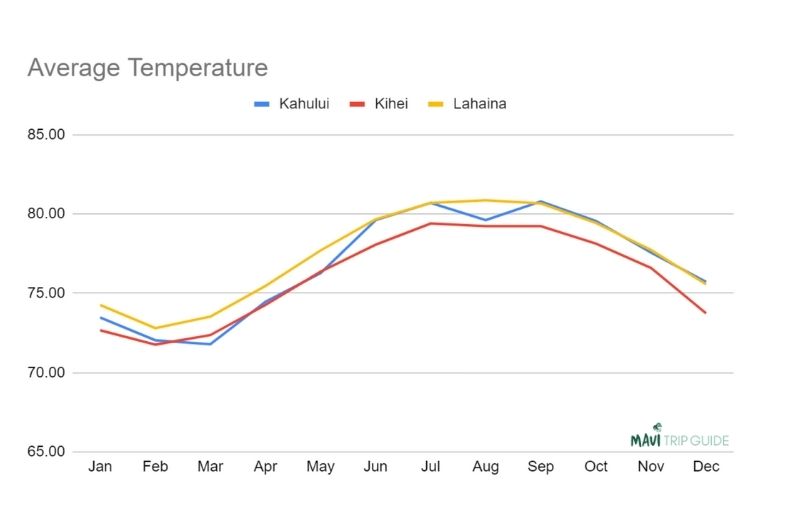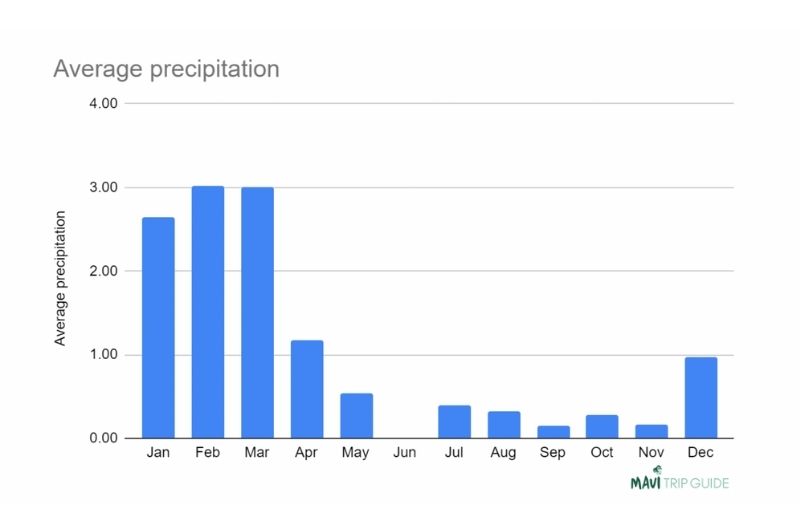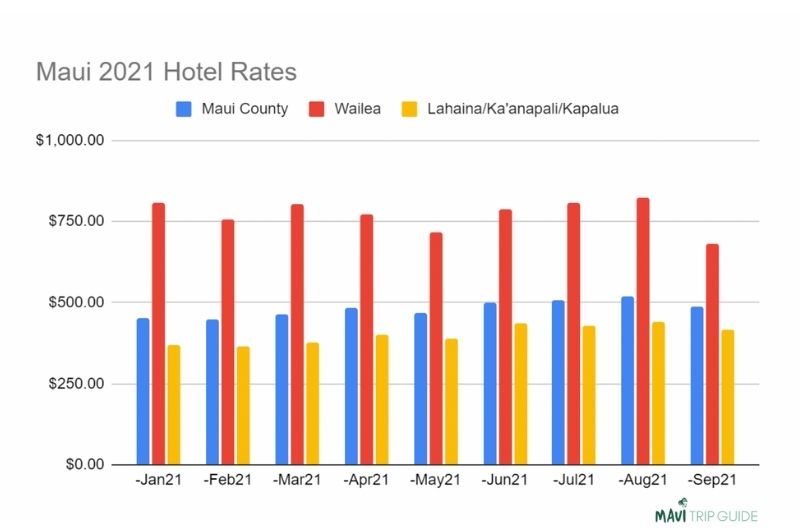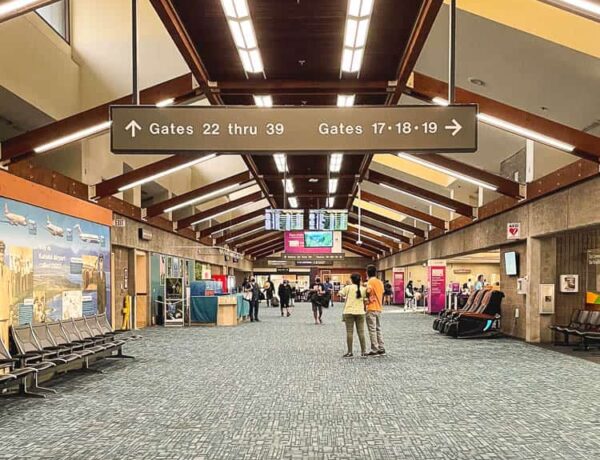You’ve decided to finally take that Maui vacation you’ve always talked about. And it’ll be the trip of a lifetime. There’s just one hitch — when’s the best time to visit?
If you ask around you’ll get all sorts of answers about the best time to book your Hawaii vacation. So we decided to look at the data instead. During which months can you expect fewer crowds, the best pricing, and the best weather?
Table of Contents
- Our new strategy for deciding when to book — look at the data
- What is the best month to go to Maui?
- Maui has a mild climate year round
- Avoid the crowds by visiting Maui in the fall
- The best month to book a hotel in Maui
- Fly in March for the best rate — usually
- Is there a bad time to visit Maui? Not really
It was early May when we stayed at Marriott’s Wailea Beach Resort. After a late breakfast one morning, John and I sauntered over to the pool area with our beach towels, ready to pounce on any open chaise lounge we could find.
That’s when we stumbled upon the resort’s NALU adventure pool. And we couldn’t believe our eyes.
It wasn’t the 325-foot water slide that shocked us. (Which is reportedly the longest slide of the Maui resorts.) No, we had to pick our jaws off the ground because the pool area was empty.
Not one person — no keiki (child), parent, or other guest — in sight.
It was like having a private pool resort all to ourselves. And with the exception of a few teenagers and resort staff cruising by from time to time, the NALU pool remained quiet while we lounged on the open chaise recliners for the afternoon. (Okay, we may have taken advantage of the water slide a few times.)
Our new strategy for deciding the best time to book a Maui trip — look at the data
Later, we realized that we’d unwittingly booked our stay during one of Maui’s slower weeks. The resort’s occupancy happened to be pretty low that day. And so I made a mental note: Try to book our Maui trips around that time every year.
Since then, I’ve wondered what other times of the year would be good for booking a trip to Maui. For us, it’s when the island isn’t crowded, when we can get lodging and airfare without paying through the nose, and when the weather isn’t too hot or rainy.
So we collected the data for the past few years and analyzed the variables that tend to affect your stay — from the weather, to the number of incoming visitors, to the price of hotel rooms.
Here’s what we discovered.
What is the best month to go to Maui?
The best time to visit Maui is during the island’s slower (shoulder) season: April, May, September, or October. You’ll fight fewer crowds on the beach and avoid the more extreme summer heat.
If whale watching is on your bucket list, opt for early spring rather than fall. Peak whale watching happens from mid-January and March, although you can still spot whales from November through May.
Maui has a mild climate year round
Maui enjoys a temperate climate year round with average temps in the 70s and 80s, making the island a popular destination for snowbirds looking to escape the droll winter weather of their hometown, as well as a popular getaway for families during school breaks. While you’ll encounter the occasional tropical downpour, the climate typically remains warm and humid.
That said, the island weather can differ depending on where you happen to be on the island. Most visitors congregate on the balmy leeward side in West or South Maui: Lahaina, Ka’anapali, Kihei, and Wailea. Because of the island tradewinds, these areas offer more shelter from the wind when compared to the North and East sides of Maui.
And if you’re heading toward the Haleakala region, where the island’s dormant volcano looms, you can expect much cooler temperatures, by at least 10+ degrees Fahrenheit. The winds can also pick up quite a bit at this elevation. If you’re hankering to watch the sunrise or sunset on the mountain, be sure to bundle up.

What is the warmest month in Maui?
The island’s warmest month is typically September at an average 80.8 degrees, according to data obtained over the past three years from the Kahului Airport weather station. July and August, however, have nearly identical average temps, at 80.7 and 79.6 degrees.
Overall, visitors will find average Maui temps in the high 70s and low 80s from the months of June through October. Weather stations in Lahaina and Kihei areas report similar trends with a few degrees variance, as seen in the chart below.
What is the coldest month in Maui?
On the other hand, late winter and early spring bring Maui’s coolest months. March typically sees the chilliest month at a 71.8 degree average over the past three years. February runs a close second at 72 degrees.
When is the rainy season in Maui?
Downpours can happen at any time of the year on Maui (at any moment, really), but the wettest months tend to be January through March. According to data we compiled from the Kahului Airport’s weather station, the island’s average precipitation levels for the past three years have spiked during the late winter and early spring months.
For the best chance at avoiding rain, the month of June sees the least amount of precipitation compared to the rest of the year.

When is Maui’s hurricane season?
According to Hawaii’s Center of Public Health Preparedness, the Hawaiian islands are most susceptible to hurricanes and tropical storms from June through November. However, storms can crop up at any time of the year. Before your Maui visit, it may be wise to monitor potential stormfronts near the Hawaiian islands via the Central Pacific Hurricane Center’s website.
Avoid the crowds by visiting Maui in the fall
Historically, visitors to Maui have the best chance of avoiding crowds by visiting during the slower fall months of September and October, when visitor numbers drop.
How the pandemic has changed Maui’s tourism numbers
The pandemic has transformed travel and tourism around the globe. Whether from testing requirements or remote workers taking advantage of an untethered office life, the number of travelers to Maui since the beginning of 2020 has fluctuated dramatically.
In the pre-pandemic years of 2018 and 2019, Maui received the fewest visitors by air in the month of September. Other traditionally slow travel times include the spring months of February, April and May.
Then 2020 happened. Pandemic travel restrictions completely obliterated Maui’s 2020 tourism figures, with as few as 647 travelers landing on the island in April. And although it looked like tourism would bounce back beginning in the summer of 2021, the Delta variant cut numbers dramatically. Looking forward, it’s anyone’s guess how the pandemic will continue to impact Maui’s tourist seasons.
What is the busiest month in Maui?
Maui typically sees the most visitors in the month of July, according to 2019 travel figures. In the same year, there were nearly 46% more tourists on the island in July than the slowest time of the year in September.

The best month to book a hotel in Maui
[Source: Hawaii Tourism Authority]
In 2019, the best time to book a Maui county hotel room was in the month of September, at an average nightly rate of $316.01. Tourists staying in Wailea paid an average of $460.63 that same month, while visitors in Lahaina, Ka’anapali, and Kapalua paid $276.04 on average.
Conversely, December was the costliest month in 2019 to book a Maui county hotel room. With an average daily rate of $540.05, visitors paid a whopping 70% more than September’s average room rate.
Typical room rates at the end of 2021
Room rates have yet to stabilize due to the uncertainty of the pandemic. Fluctuations include a surge of travelers in the summer of 2021 as travel opened up again, and a subsequent drop-off in the fall when Hawaii’s governor asked tourists to hold off on travel to the islands because of the surging Delta variant.
As of data made available in November 2021, the available room rates for the year show that Maui county rates held steady for the first quarter. Heading into the summer months, daily rates rose to a peak of $520.82 in August 2021 before declining again the following month.

We may see pre-pandemic trends re-emerge as more people start traveling again, but we forecast that average hotel room rates will continue to increase overall with rising inflation, labor costs, and taxes.
Pro tip: You may find a lull during certain weeks of the month, even during busy months. December, for example, is generally considered high season. But we recently booked a stay during the first two weeks of the month. Prices (and overall occupancy) were low because we booked between some of the busiest travel weeks of the year — Thanksgiving and Christmas.
Fly in March for the best rate — usually
According to travel search engine Kayak, you get the cheapest ticket price when you fly to Maui in the month of March. You’ll typically pay the most during the high season: January, November, and December.
Here’s the rub, though. Your departure city greatly affects which month is best for the cheapest flight. This is the best month to fly to Maui according to Faredetective’s Airfare History Chart.
| Departure airport | Cheapest month to travel | Lowest price found | Average price |
| Atlanta (ATL) | November | $390 | $539 |
| Austin (AUS) | October | $381 | $760 |
| Chicago (ORD) | April | $483 | $842 |
| Fort Lauderdale (FLL) | March | $402 | $544 |
| Las Vegas (LAS) | April | $405 | $629 |
| Los Angeles (LAX) | October | $286 | $543 |
| New York (JFK) | October | $312 | $742 |
| San Francisco (SFO) | March | $188 | $442 |
| Seattle (SEA) | March | $252 | $454 |
Is there a bad time to go to Maui? Not really
It’s Maui! You’ll have an amazing time on this slice of paradise year round. Here’s our ultimate advice: book a flight and accommodations that suit both your budget and your calendar, no matter the month. You’ll love Maui any time of the year.


